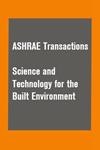Within- and cross-domain effects of environmental factors on students’ perception in educational buildings
IF 1.6
4区 工程技术
Q3 CONSTRUCTION & BUILDING TECHNOLOGY
Science and Technology for the Built Environment
Pub Date : 2023-07-21
DOI:10.1080/23744731.2023.2239080
引用次数: 0
Abstract
Students in classrooms are exposed to environmental stimuli in the thermal, visual, acoustic and air quality domains, which affect their overall comfort and performance. Therefore, in recent studies, questionnaires are used to collect information about subjective perceptions and investigate links with physical parameters. Most field studies in educational buildings either focus on a single comfort domain, or consider multiple domains but provide inconsistent questions among the 4 domains (i.e., IAQ, thermal, visual and acoustic). Very few studies have investigated cross-domain effects in a consistent manner, considering satisfaction, comfort and perception aspects. To address this research gap, a survey with consistent questions among the 4 comfort domains was designed and used to collect more than 900 subjective responses from students. The analysis of subjective data together with objective measurements allows: (i) correlating the environmental physical parameters and students’ perception in each of the comfort domains; (ii) understanding the students’ preferred environmental conditions; and (iii) understanding cross-domain effects, i.e., the effects between the average conditions and the mean vote expressed for another domain. The results show that air temperature, illuminance and sound pressure level are correlated with the sensation in the respective domains, in contrast to CO2 concentration. Regarding cross-effects, the study confirms interference of CO2 concentration and illuminance on thermal sensation as well as the effect of sound pressure level on visual sensation.教育建筑中环境因素对学生感知的域内和跨域影响
教室里的学生暴露在热、视觉、声学和空气质量领域的环境刺激下,这会影响他们的整体舒适度和表现。因此,在最近的研究中,问卷被用来收集有关主观感知的信息,并调查与物理参数的联系。大多数教育建筑的实地研究要么集中在一个舒适度领域,要么考虑多个领域,但在4个领域(即室内空气质量、热、视觉和声学)之间提出了不一致的问题。很少有研究以一致的方式调查跨领域效应,考虑到满意度、舒适度和感知方面。为了解决这一研究差距,设计了一项在4个舒适度领域中具有一致问题的调查,并用于收集学生的900多个主观回答。主观数据的分析和客观测量允许:(i)将环境物理参数和学生在每个舒适领域的感知联系起来;(ii)了解学生喜欢的环境条件;以及(iii)理解跨领域效应,即平均条件和对另一个领域表达的平均投票之间的效应。结果表明,与CO2浓度相比,空气温度、照度和声压水平与各个领域的感觉相关。关于交叉效应,该研究证实了CO2浓度和照度对热感觉的干扰以及声压水平对视觉感觉的影响。
本文章由计算机程序翻译,如有差异,请以英文原文为准。
求助全文
约1分钟内获得全文
求助全文
来源期刊

Science and Technology for the Built Environment
THERMODYNAMICSCONSTRUCTION & BUILDING TECH-CONSTRUCTION & BUILDING TECHNOLOGY
CiteScore
4.30
自引率
5.30%
发文量
78
期刊介绍:
Science and Technology for the Built Environment (formerly HVAC&R Research) is ASHRAE’s archival research publication, offering comprehensive reporting of original research in science and technology related to the stationary and mobile built environment, including indoor environmental quality, thermodynamic and energy system dynamics, materials properties, refrigerants, renewable and traditional energy systems and related processes and concepts, integrated built environmental system design approaches and tools, simulation approaches and algorithms, building enclosure assemblies, and systems for minimizing and regulating space heating and cooling modes. The journal features review articles that critically assess existing literature and point out future research directions.
 求助内容:
求助内容: 应助结果提醒方式:
应助结果提醒方式:


